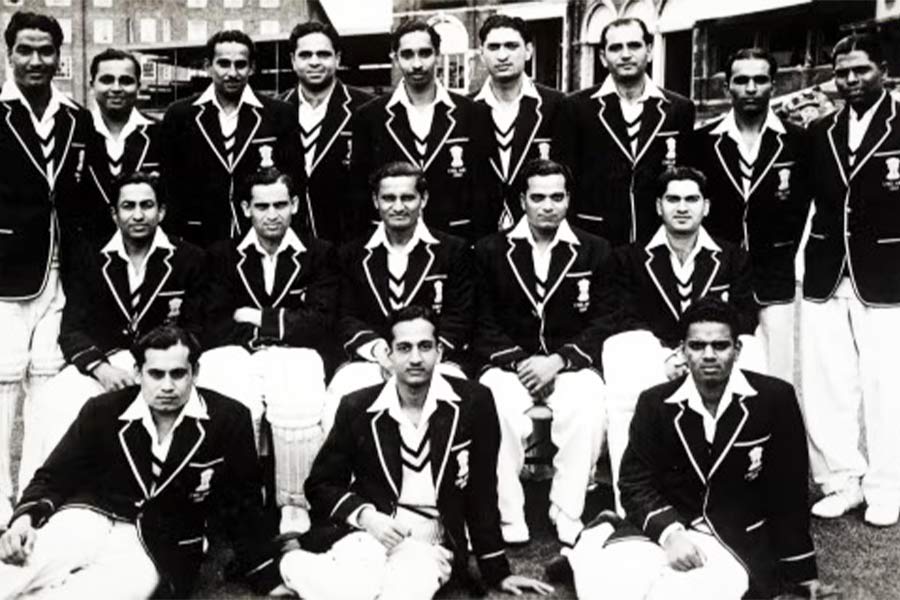- 25th June, 1932. Lord’s Cricket Ground, London, England
- 22nd September, 2024. M.A. Chidambaram (Chepauk) Stadium, Chennai, India
Ninety-two years and three months (almost). That’s how long it took the Team India to get on the right side of the win/loss record in test match cricket. With the comprehensive win over Bangladesh in the first test of the series recently, for the first time in its cricket history, India had more wins (179) than losses (178) (then). For long-time watchers of the game, like this author, words are not enough to describe this moment – one we were not even sure would ever arrive. But in the new millennia, the Indian team has gone from strength to strength, winning a 50-over World Cup. Two T20 world titles and also becoming the No. 1 test team. The win over Bangladesh put the cherry on the cake.
But like all journeys, this one also had a beginning. And by happy coincidence, that beginning was also in Chennai – or Madras as it was better known back then. Nearly 20 years after its first official test match, Indian cricket team finally registered its first Test match victory. And what made it doubly special from Kolkata’s point of view was the fact that two city boys played a vital role in fashioning that win.
In April of 1950, it was announced after a meeting of the officials of the Indian and Pakistan cricket boards in Bombay that a Marylebone Cricket Club (MCC) team will be touring the sub-continent during the winter of 1951, spending a four and half months in India, one month in Pakistan and two weeks in Ceylon (present-day Sri Lanka). During the tour, the team would play all first-class matches as MCC and five test matches in India as England. The test matches were to be played in Delhi, Bombay, Calcutta, Kanpur and Madras. This was to be only the 2nd official tour of India by the MCC – the previous one had taken place in 1933-34 – and the first after the Independence of India in 1947. It was thus a sentimental tour in more ways than one.
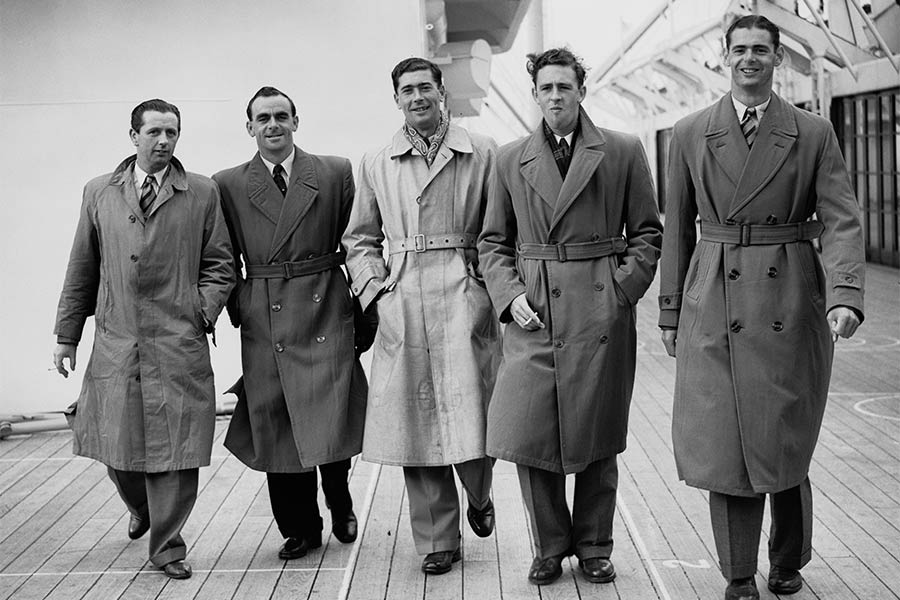
Some of the members of the MCC contingent Getty Images
For Indian cricket fans, it was to be the first opportunity to witness the exploits of some of the giants of the English game. Sadly, those hopes never came to fruition. As it turned out, most of England’s big names chose to skip the tour. There was no Compton, Hutton, Bedser, Evans or Bailey. As a matter of fact, the party did not include a single player from the MCC team that toured Australia and New Zealand the previous winter. Eight members of the squad, including the captain Nigel Howard, had never played test cricket before and no one had reached double figures in terms of number of test matches.
It was the sort of condescending behavior on part of English cricket that continued well into the 1970s and stood in sharp contrast to the attitude of the Australians, who, right from their first official tour of India in 1955-56, always sent their best players. If the Indians needed to find some righteous anger, the fact that MCC was essentially declaring the former colony as a pushover in cricket should have proven sufficient.
After a slew of first-class fixtures against Indian universities, Western India, North Zone and Services, it was time for the first Test in Delhi. The two stalwarts of Indian batting, skipper Vijay Hazare and the venerable Vijay Merchant, both hit big centuries but the match petered out into a draw. The match marked the test debut of a young man from Calcutta by the name of Pankaj Roy, who opened the batting with Merchant, but was dismissed for only 12.
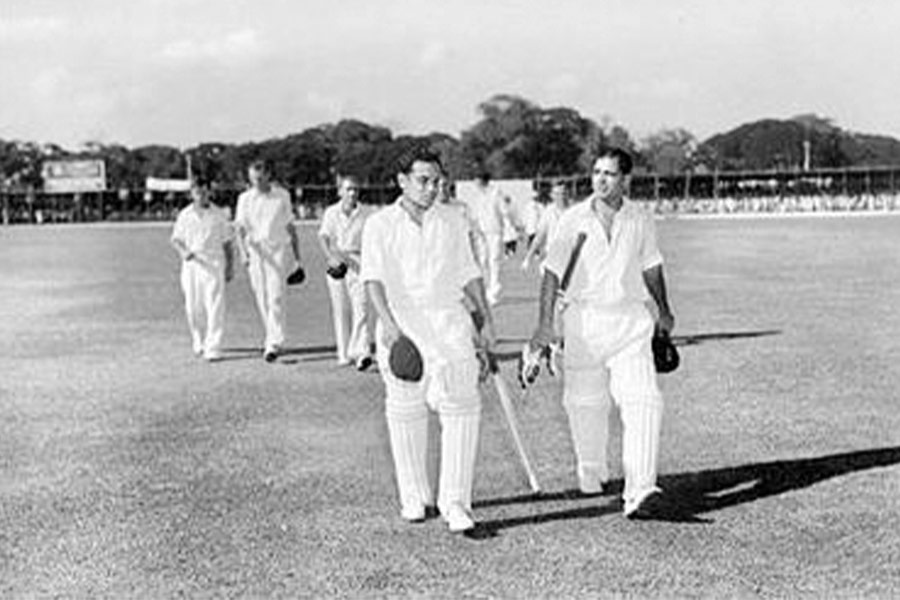
Vinoo Mankad and Pankaj Roy
The next two tests in Bombay and Calcutta were also drawn. But in Bombay, Pankaj Roy became the first Bengali cricketer to score a test century. Kanpur brought ill tidings as the tourists, practically a B side, humiliated India by securing a facile 8 wicket win inside 3 days. India now had to do something they had never done till then to square the series – win a test match. The debacle of Kanpur prompted wholesale changes in the playing XI. Among those who were named in the playing XI was another Calcutta boy: Probir ‘Khokan’ Sen, who donned the big gloves. His name was to soon enter the record books.
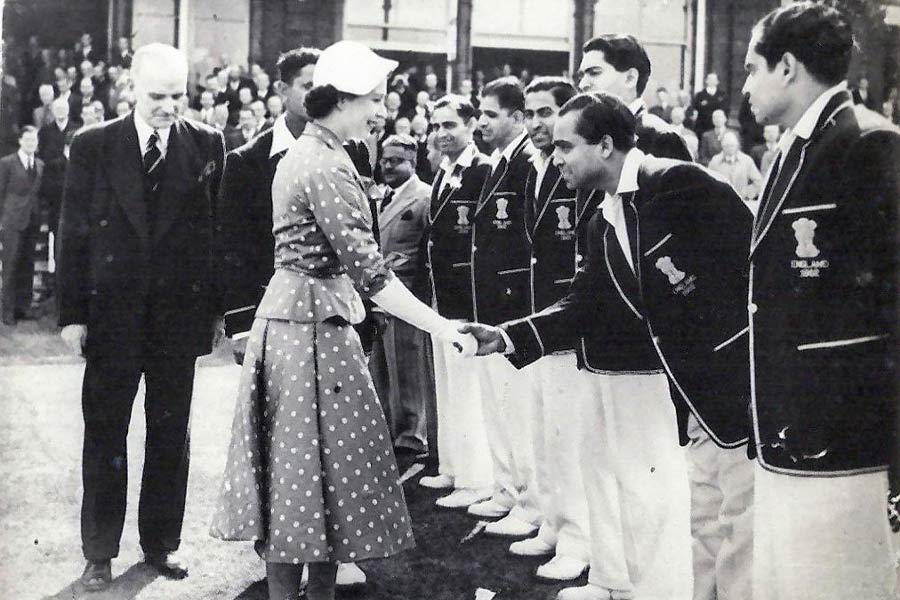
Probir ‘Khokan’ Sen with Queen Elizabeth II
February 6, 1952. Nigel Howard, the English captain, was afflicted with pleurisy and missed the match. Donald Carr deputised for him and correctly called at the toss. Playing it safe, Carr opted to bat first. Dattu Phadkar got an early breakthrough, castling Frank Lowson for just a single. However, keeper Dick Spooner and Tom Graveney, later chairman of selectors, batted steadily to prevent further damage. With the score on 71, the great Vinoo Mankad struck by having Graveney stumped by Sen. Spooner and Jack Robertson added a further 60 runs before skipper Hazare provided a much-needed breakthrough, dismissing Spooner for 66.
Mankad now ran riot. Despite an accomplished 77 from Robertson, the rest of the English batting had little clue of the wiles of the left armer, as he registered career-best returns of 8 for 55. Apart from skipper Donald Carr, who made 40, no one in England’s 5-11 crossed 15 runs. Khokan Sen also made an indelible mark by stumping four batsmen. It was only the second time in test cricket’s history that a keeper had claimed four stumped victims in an innings.
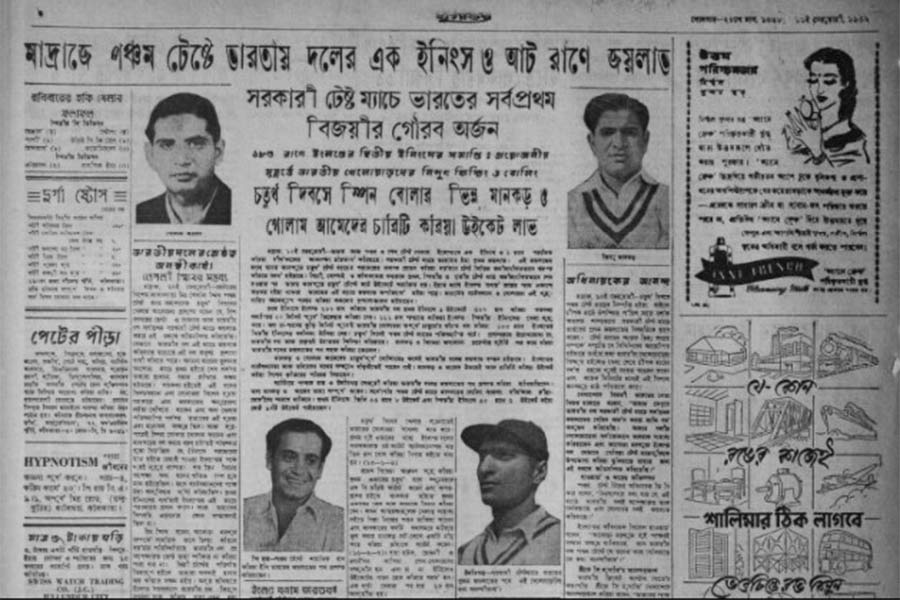
The match report from ‘Jugantar’
With England shot out for just 266, it was time for India to seize the advantage. And now, the other Calcutta boy stepped up. Pankaj Roy compiled 111 – his second century of the series – in nearly four hours of batting. Polly Umrigar also made a hundred as India declared on 457/9 – a lead of 191. On a last-day Chepauk wicket, it was always going to be a Herculean battle for the inexperienced Englishmen. Mankad was once more the tormentor. And this time, he was joined by off-spinner Ghulam Ahmed. The spin twins snared four victims apiece and despite some stiff resistance from Robertson – who made his second half-century of the match – and Wilkins (48), England were all out for 183, still eight runs short of making India bat again. Khokan Sen claimed another stumping – again off Mankad’s bowling – and entered the record books as the first keeper to have five stumping dismissals in a test match.
February 10, 1952. Nearly 20 years and 24 test matches later, the Indian cricket team had finally broken the deadlock. They now could show an entry under the “W” column. The fact that it came against the old colonial masters must have made it doubly sweet.
Brief scores: India 457/9 (decl.) defeated England 266 & 183 by an innings and 8 runs. India’s playing XI for Madras, 1952 (in batting order): S Mushtaq Ali, Pankaj Roy, Vijay Hazare (C), Vinoo Mankad, Lala Amarnath, Dattu Phadkar, Polly Umrigar, C. Gopinath, Ramesh “Buck” Divecha, Probir “Khokan” Sen (w), Ghulam Ahmed.
